1. Ration and its Comparison
- Books Name
- CBSE Class 6 Mathematics Book
- Publication
- Param Publication
- Course
- CBSE Class 6
- Subject
- Mathmatics
Ratio
A ratio is a comparison of two numbers (quantities) by division. A ratio is usually denoted by the symbol (:). The ratio of a to b (b ≠ 0) is written as a : b or ![]()
In the ratio a : b, a and b are called terms of the ratio. 'a' is the antecedent and 'b' is the consequent.
A ratio is a number, so to find the ratio of two quantities they must be expressed in the same units.
Properties of Ratios
(a) In a ratio, two quantities are compared. So, the quantities must be of the same kind. i.e., they must be expressed in the same units.
(b) The value of a ratio remains unaltered if the given ratio is multiplied or divided by the same non-zero quantity.
(c) The order of the terms in a ratio a : b is very important. The ratio 3 : 2 is different from the ratio 2 : 3.
Ratio in the simplest or lowest form :

Ex.1 Find the ratio of the following :
(a) 36 minutes to 2 hours.
(b) 32 g to 1 kg
(c) 3 days to 1 years.
Sol. (a) Change both 36 minutes and 2 hours to the same unit.
Now, 36 minutes = 36 minutes
2 hours = 2 × 60 minutes = 120 minutes
∴ Ratio of 36 minutes to 2 hours

(b) First convert both into numbers with the same unit.
32 g = 32 g
3kg = 3000 g

(c) First , convert both into numbers with the same unit.
3 days = 3 days
1 year = 365 days
Ratio = 3 : 365
Ex.2 Find the (i) ratio of M20 to M80 (ii) ratio of 3 km to 600m
Sol. (i) 20 : 80 or 1 : 4
(ii) 3000m : 600m or 3000 : 600 or 5 : 1
Comparison of Ratios :
1. Write the given ratios as fractions in the simplest form.
2. Find the LCM of the denominators of the fractions.
3. Convert them into like fractions with same denominators .
4. Compare the numerators and arrange the fractions.
5. Then respective ratios are also in the same order.
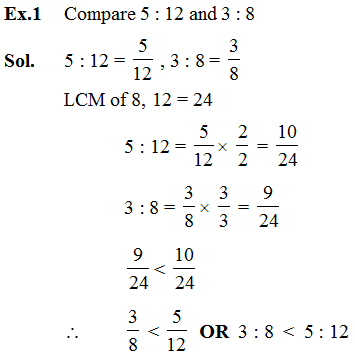
Ex.2 Two numbers are in the ratio 4 : 5. If the sum of the number is 63, then find the numbers.
Sol. Here 63 is to be divided in the ratio 4 : 5.

Ex.3 Mr. Harry divided Rs. 84,630 between Shinchan and Nimavari in the ratio 3 : 4. How much did each of them get ?
Sol. Ratio of money between Shinchan and Nimavari = 3 : 4
Sum of the terms of the ratio = 3 + 4 = 7
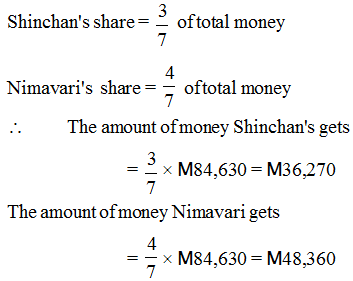
2. Proportion and Unitary Method
- Books Name
- CBSE Class 6 Mathematics Book
- Publication
- Param Publication
- Course
- CBSE Class 6
- Subject
- Mathmatics
Equivalent Ratios
Therefore, we can get equivalent ratios by multiplying or dividing the numerator and denominator by the same number.
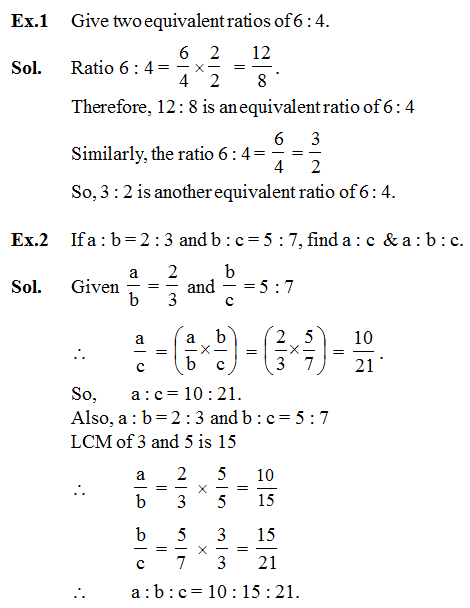
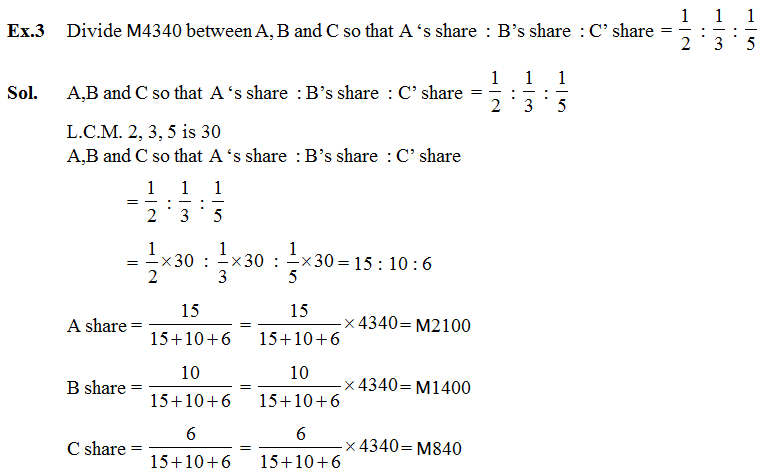
Proportion
- Books Name
- CBSE Class 6 Mathematics Book
- Publication
- Param Publication
- Course
- CBSE Class 6
- Subject
- Mathmatics
Proportion
An equality of two ratios is called a proportion. If two ratios are equal, we say that they are in proportion and use the symbol ‘::’ or ‘=’ to equate the two ratios.
For the example, we can say 3, 10, 15 and 50 are in proportion which is written as 3 : 10 :: 15 : 50 and is read as 3 is to 10 as 15 is to 50 or it is written as 3 : 10 = 15 : 50 
In the proportion, the first and the fourth terms are called the extremes or extreme terms. The second and the third terms are called the middle terms or means.
In case of proportion, we can say that the product of the extreme terms = the product of the middle terms.
∴ Product of extremes = product of means
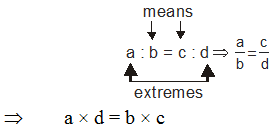
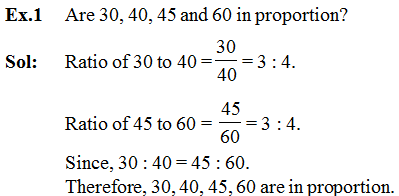
Ex.2 Do the ratios 15 cm to 2 m and 10 sec to 3 minutes form a proportion?
Sol. Ratio of 15 cm to 2 m = 15 : 2 × 100 (1 m = 100 cm) = 3 : 40
Ratio of 10 sec to 3 min = 10 : 3 × 60 (1 min = 60 sec) = 1 : 18
Since, 3 : 40 ∷ 1 : 18, therefore, the given ratios do not form a proportion.
Unitary method
- Books Name
- CBSE Class 6 Mathematics Book
- Publication
- Param Publication
- Course
- CBSE Class 6
- Subject
- Mathmatics
Unitary method
Let we see a problem.
If the cost of 3 pens is M12, what will be the cost of 8 pens ?
We have to find the cost of 8 pens, we know that it will be more than the cost of one pen. So we multiply M4 by 8 and we get M32. So the cost of 8 pens is M8 × 4 = M32
In the process of our calculation we found out the value of one unit (in this case cost of one pen)
So this method of solving is called unitary method.
The method in which first we find the value of one unit and then the value of required number of units is known as Unitary Method.
Ex.1 If the cost of 6 cans of juice is M210, then what will be the cost of 4 cans of juice?
Sol. Cost of 6 cans of juice = M210

Ex.2 A motorbike travels 220 km in 5 litres of petrol. How much distance will it cover in 1.5 litres of petrol?
Sol. In 5 litres of petrol, motorbike can travel 220 km.

Ex.3 If the cost of a dozen soaps is M153.60, what will be the cost of 15 such soaps?
Sol. We know that 1 dozen = 12
Since, cost of 12 soaps = M153.60


 ReginaTagebücher
ReginaTagebücher
 Param Publication
Param Publication
